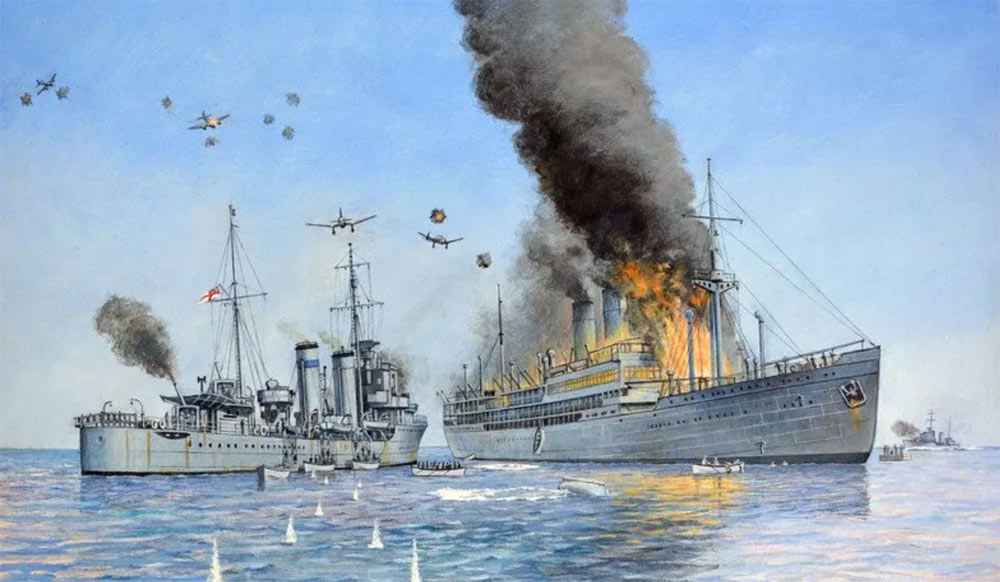The sinking of the SS Slamat, HMS Diamond and HMS Wryneck - on 27th April 1941
during the evacuation of troops from Greece
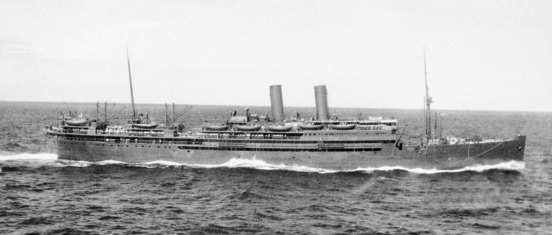 The
Italian invasion in October 1940, usually known as the Greco-Italian
War, was followed by the German invasion in April 1941. German landings
on the island of Crete (May 1941) came after Allied forces had been
defeated in mainland Greece. The most authorative and detailed account
of the evacuation of the troops from Greece was published in Supplement 38293 to The London Gazette on Tuesday 18 May 1948.
It contains the official accounts of the senior officers responsible
for directing the operation to take allied troops to Greece (Operation Lustre) and Operation Demon to evacuate them after the fall of Greece to German forces, It has been saved as a PDF so that it can
be read online on this website. Although a great tragedy the loss of
HMS Wryneck was only a small part of this operation which successfully evacuated 50,000 troops.
The
Italian invasion in October 1940, usually known as the Greco-Italian
War, was followed by the German invasion in April 1941. German landings
on the island of Crete (May 1941) came after Allied forces had been
defeated in mainland Greece. The most authorative and detailed account
of the evacuation of the troops from Greece was published in Supplement 38293 to The London Gazette on Tuesday 18 May 1948.
It contains the official accounts of the senior officers responsible
for directing the operation to take allied troops to Greece (Operation Lustre) and Operation Demon to evacuate them after the fall of Greece to German forces, It has been saved as a PDF so that it can
be read online on this website. Although a great tragedy the loss of
HMS Wryneck was only a small part of this operation which successfully evacuated 50,000 troops.
The SS Slamat was
a twin-prop ship of 11,636 tons of the Rotterdamsche Lloyd (RL). The
vessel was launched in 1924 by shipyard De Schelde in Flushing carrying
passengers between Rotterdam and the Dutch Dutch East Indies. In order
to compete with faster newer ships Slamat
was modernized in 1931. Her length was increased to
155.5 meters by altering the bow which enabled the De Schelde
steam turbines to increase the ship's speed from 15 to 17 knots. The Slamat was in Batavia, capital of the Dutch East Indies, when Germany invaded
the Netherlands in May 1940. She
was chartered by the British
Ministry of War Transport and converted into a troop-ship (on left) in Sydney,
Australia. She was mainly
deployed in the Indian Ocean and Mediterranean carrying
British Empire troops to Egypt until the Italian invasion of
Greece in October 1940.
The sinking of the SS Slamat is described as "the greatest disaster in Dutch Merchant Navy History" on the website of the Museum of her shipowner Rotterdamsche Lloyd (RL). The part played by the Dutch Liner Slamat in the evacuation and the rescue of survivors from the Slamat by Wryneck and Diamond and the sinking of all three ships is described below.
***********
In the afternoon of 26 April, 1941,
Slamat, HMS
Glenearn and
Khedive Ismail of 7,290 ton (under Egyptian flag) escorted by the cruiser HMS
Calcutta and five destroyers were directed from Crete to evacuate the troops from Nauplia in the in the Peloponnese. The
Glenearn,
an LSI (Landing Ship Infantry), was bombed and a bomb hit the engine room stopping the LSI dead in the water. The destroyer HMS
Griffin was ordered to tow the landing ship back to Crete. The loss of the
Glenearn
was a bitter set back; their landing craft would have madeb the evacuation of the troops much easier.
In the evening the ships dropped anchor in the bay at Nauplia. The harbour was still blocked by the wreck of the Ulster Prince
and since the landing craft of the Glenearn were not available the troops could only be ferried to the ships in the
life-boats of the ships themselves and some small loocal boats. The
cruisers HMS Orion and HMS Perth and the destroyer HMS Stuart which had replaced HMS Glenearn, took the first 2,500 troops aboard. By 03.00 the Khedive Ismail had taken aboard no troops at all and Slamat only a few hundred, when HMS Calcutta signalled that departure was due. Captain T. Luidinga of the Slamat knew that hundreds of evacuees remained on shore and against orders he continued to embark troops. HMS Calcutta and the Egyptian ship only departed at 04:00 and Slamat
at 04:15. In spite of the decision by captain Luidinga to
board more troops there were only 600 troops onboard, only half of her capacity.
After a few hours they were attacked in the Sea of Pelagos by nine German Ju 88 bombers and the
Slamat (on left)
received
a direct hit between the bridge and the foremost chimney which
caused a fierce blaze. The crew tried to control the fire but this was
made more difficult by heavy machine gun strafing by
Messerschmitt Bf 109 fighter airplanes and Ju 87 (Stuka) bombers. The
ship received another near-miss and started to list.
Captain Luidinga ordered abandon-ship. The life boats and
rafts which had been left were inadequate and
two overcrowded life-boats capsized. To make things worse
the drowning troops were machine gunned in the water by the German
planes while the other ships maintained heading and speed. HMS
Calcutta took a few survivors aboard and ordered the destroyer HMS
Diamond to stay and rescue as many survivors as possible.
HMS
Wryneck and two V & W destroyers in the Australian Navy, HMAS
Vendetta and HMAS
Waterhen, were ordered from Souda Bay in Crete to reinforce the escort for the Convoy. HMS
Wryneck was ordered to assist HMS
Diamond in rescuing survivors from the
Slamat. After rescuing as many men as possible HMS
Wryneck fired a torpedo at the
Slamat which sank her within minutes. HMS
Diamond already had about 600 victims onboard and HMS
Wryneck
another few dozen and at 13:00 headed for Crete. A
quarter of an hour later both ships were attacked by Ju87 dive
bombers coming out of the sun. HMS
Diamond received two hits and sank within eight minutes. HMS
Wryneck received three hits, capsized on her port side and sank within fifteen minutes. The crew of the
Wryneck
had been able to lower a single life-boat and both destroyers had
launched their three Carley rafts. The capacity of these was far short of what was needed and hundreds drowned,
especially those wounded.
This is an extract from p3053 of the Supplement to the London Gazette referred to above.
Loss of Diamond and Wryneck
When it was realised that Diamond had not arrived with Phoebe and other destroyers I became anscious about her. From 1922 to 1955 Diamond had been called without reply. As Diamond had last been heard of with Wryneck during the forenoon, Phoebe and Calcutta were asked whether Wryneck hd been seen going away with GA.14 since I did not wish to ask Wryneck herself to break to break W/T silence. Their replies at 2235 and 2245 gave no definite indication. I therefor despatched Griffin to the position of the sinking of the Slamat to investigate. At 0230 Griffin rerported that she had come upon a raft from Wryneck and everything pointed to the fact that both Wryneck and Diamond were sunk. HMS Griffin picked up about 50 survivors. Wryneck's
whaler was reported to have made towards Cape Malea. This eventually
arrived at Suda. The total naval survivors from the two ships
comprised one officer and 41 ratings. There were, in addition, about 8
soldiers. From statements of the survivors, it appears tht the two
ships were bombed at about 1315 both receiving hits which caused them
to sink almost immediately.
In the evening of 27 April the destroyer HMS
Griffin was sent out to establish why HMS
Diamond and HMS
Wryneck had failed to return.
Griffin found two rafts at the spot where
Slamat had sunk. Fourteen survivors were picked up and next morning another four, who were taken to Crete. The life-boat of HMS
Wryneck
reached a little rocky island thirteen miles south east of Milos on
the 28th of April. Here they found a Greek fishing boat full up with
Greek and British refugees from Piraeus. That evening the
fishing boat and the life-boat sailed for Crete and were spotted during
the night by a landing craft on its way with refugees from Port
Raphtis. All the evacuees were taken aboard the landing craft and
arrived safely at Crete.
The Sinking of HMS Wryneck
The men who died
Cdr Douglas-Lane was appointed CO of HMS Wryneck on 26 July 1940 during her refit in Malta Dockyard, a month before she was placed in Commission on 29 August, The Admiralty records of her activities between then and her loss can be seen on U-Boat.net
On the 25 April HMS Wryneck was
ordered to Greece to evacuate the Australian 6th Division Signals from
Megara near Pireus, the main port for Athens, east of the entrance to
the Corinth Canal. She replaced HMS Pennland, a former Atlantic passenger liner requisitioned by the Ministry of War Transport (MOWT) and converted into a troop carrier, bombed and sunk the previous night.
These two photographs from the Australian War Memorial website show the
647 troops of the Australian Signals Division crowding the deck of Wryneck
(left) and gratefully accepting loaves of bread handed to them by the
crew of an oil tanker (on right), the first bread that the men had
eaten for three
weeks. ERA Stanley Gordine began his Diary on this day and noted
"Troops
line the deck and use Bren and Tommy guns for dive bombers. We lash the
boys up with cocoa and biscuits. Couldn't give them any food as
we had been living for days on corned beef and biscuits. Troops slept
all over the decks. Eventually reached Suda Bay in Crete without
seeing one of our aircraft but plenty of Jerrys. Troops all off by by
1700."
Wryneck was sunk two days later.
The names and fates of all the men in Wryneck when she sunk are recorded on the list of crew members compiled by Ian McLeod
from official records in The National Archives, Kew, and by Brian
Crabb for his book on Operation Demon,
the evacuation of troops from
Greece. Amongst the men who died were the Commanding Officer, Lt Cdr
Robert Henry Douglas Lane RN, and five of his officers. John Reginald
Batt CM/X 53459, Leading Supply Assistant, was one of the hundred
ratings who were killed. His story is told below by his his great
nephew, Andrew Lyle, in Australia.
Lt Cdr Robert Henry Douglas Lane RN
Robert Henry Douglas Lane was born
on 15 February 1896, the son of “Charles M.R. Douglas Lane Esq,
Gentleman” (the entry on his Service Certificate) and joined the Navy
on 10 January 1909 when he was thirteen. His hand written service
certificate is difficult to read and to interpret but after gaining one
months seniority on passing out from Dartmouth Naval College he was
appointed Midshipman on 15 September 1913 and on the outbreak of
hostilities in August 1914 was serving in the battleship HMS Africa. Two years later to the day he was promoted to Acting Sub Lieutenant and on 15 November 1915 joined HMS Hindustan
in the 3rd Battle Squadron. By the 15 October 1917 he was a full
Lieutenant and he completed his wartime service in destroyers, the Nonpareil and the Patriot, latterly as a “Jimmy the One", First Lieutenant.
On 15 July 1919 he was appointed 1st Lt of a former yacht and despatch vessel launched as Margarita in 1900, renamed Semiramis in 1910 and Mlada in 1913 which was requisitioned by the Admiralty in 1918 and commissioned as HMS Alacrity in 1919. HMS Alacrity had been requisitioned for use as an Admiral's yacht by the Commander-in-Chief of the China Station. This
was his introduction to the complex problems faced by the Navy in
protecting British interests on the China Station. Britain was the
first of many foreign powers to take advantage of Chinese weakness to
secure rights to trade and settle in treaty ports, concessions and
enclaves along the coast of China and major rivers. The process began
with the ceding of Hong Kong to Britain at the end of the First Opium War (1841-2) and
accelerated with the fall of the Quing dynasty and the establishment of
the Republic of China in 1912. By 1920 there were 60,000
foreigners living in the International Settlement at Shanghai, China's
largest city on the delta of the four thousand mile Yangtze River which
flowed from west to east separating north from south China. Russia, France, Germany and Japan also acquired treaty ports from the weak government and had warships on the China coast and along the Yangzte to protect their ports and citizens. He only served in Alacrity from 15 July 1919 to March 1921 but at present nothing further is known of his role in Alacrity. He returned to Britain in the troop carier SS Devanha in June 1921.
On joining Alacrity he expressed an interest in an “appointment to destroyers” and on his return to HMS Pembroke, the shore base at Chatham on the Medway, he was sent on the Gunnery Control Course (GCC) and the Short Torpedo Control Course (TCC) and served in the V & W Class destroyer HMS Viscount from 15 Dec 1921 to 28 November 1923. He was promoted to Lt Cdr in October 1925 and in October 1927 passed the examination for command of a destroyer and from 9 April 1928 – 6 May 1930 was CO of HMS Whitehall. He transferred to HMS Seraph on 6 June 1930 and joined HMS Diamond on 30 March 1932 while under construction and for her sea trials. At the outbreak of
hostilities in 1939 he was back on the China Station at HMS Tamar as Naval
Provost Marshal in Hong Kong. There is no obvious explanation for him being
appointed to this senior post ashore in the Regulating Branch of the
Navy. Was it related to his marriage to the daughter of Lord Mowbry?
He returned to the Britain in early 1940 and was given command of the ancient freighter SS Moyle, one of three blockships ordered to Dunkirk on the last night of the evacuation on 3-4 June 1940.
Lane and his crew rammed her into the west pier and scuttled her, prior
to becoming among the very last to be evacuated from the battered port.
He was subsequently among those men mentioned in despatches in The London Gazette
of 10 October 1940, for "good services when carrying out blocking
operations in enemy occupied ports". He was also MID for service in
Norway but at present nothing is known about what he did to merit this.
Lt Cdr Douglas-Lane was appointed CO of HMS Wryneck on 26 July 1940 while she was undergoing a refit in Malta Dockyard. She was placed in Commission on 29 August and served
with distinction in the Mediterranean, and more particularly
during the evacuation of Greece. Although Douglas-Lane (his name is
often hyphenated) was "Placed on retired list (age) with rank of
Commander 15 February 1941" he remained in command and two months
later was killed with five of his officers and one hundred of his men. Having
assisted in the withdrawal of troops from Megara on 25 April 1941, and
in rescuing survivors from the lighter A. 19, Lane was ordered to take
the Wryneck on a similar mission two nights later. HMS Wryneck and her
consorts departed Navplion too late to avoid enemy attention
in the first hours of daylight and at 7 am thirty enemy dive bombers
commenced a devastating attack on the Wryneck, the Diamond and the Dutch Slamat.
This description is taken from the catalogue entry for the sale of Lane's medals in 2002:
‘Wryneck, meanwhile, had been equally unfortunate. Taken unawares in the same way as Diamond,
a bomb had struck the foc’s’le near ‘A’ gun, killing or wounding
everyone at the gun, on the bridge and in the sick bay, shattering the
stokers’ mess deck and killing numbers of stokers and soldiers. Another
fell down the engine room hatch bursting all the steam pipes, and a
third bomb struck aft setting an ammunition locker on fire. With the
ship moving at about 18 knots, with a heavy growing list to port, an
E.R.A. managed to open the safety valves; then, with others, he got a
whaler away which was practically undamaged, and released the rafts
before abandoning ship ...’
The ERA Paul Gordine -
"...
never thought the ship would sink ... I put the heavy list down to the
the fact the skipper was making a heavy turn. I think that everyone
thought the same until it was too late, hence the heavy death
toll; no orders were given to abandon ship, it was when I looked
up at the bridge in the hope of seeing somebody doing something when I
saw a heap of torn papers come blowing down, that I thought it must be
serious because they are destroying confidential papers."
There
were a number of rafts and Carley floats drifting in a growing patch of
oil, and a few carried survivors. Commander Lane of the Wryneck, with two of his RNVR Sub. Lieutenants, Jackson and Griffiths, and his Midshipman Peck were on one of them.
Able Seaman Taylor helped to haul them on to the raft. They were all
badly wounded and coated in oil. For a little while they clung to the
raft as it rolled in the rising sea until they slipped off, too weak to
hold on any longer ...
When a handful of Wryneck’s men were eventually picked up, the senior surviving rating was asked to complete a report. He ended:
"The men of the Wryneck wish me to add that we have lost a fine ship, fine officers and a magnificent Captain."
Officers in the Navy List for April 1941
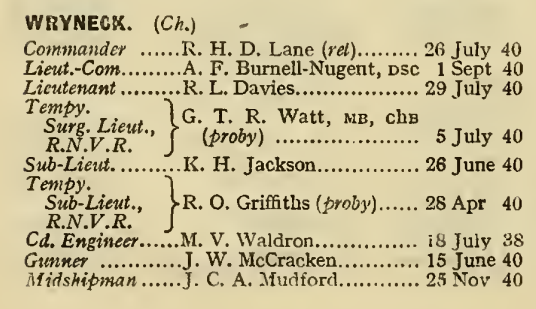 The Navy List is not always accurate
The Navy List is not always accurate
Lt Cdr Burnell-Nugent left HMS Wryneck in Jan 1941 and was in HMS Jersey when she sank on 2 May 1941
Mid Basil Peck is thought to have replaced Mudford before Wryneck was sunk
Cdr Robert Henry Douglas Lane RN and John Reginald Batt (CM/X 53459) were two of the men who died
John Reginald Batt CM/X 53459
Leading Supply Assistant
John Batt was was born on the 16th
May 1918 in Sandgate Kent to Walter Leonard Batt and Emily Elizabeth
Batt. He came from a naval family and was educated at the Royal Hospital School
which was founded at Greenwich in 1712 to provide an education for
children from a naval background. It occupied the present buildings of
the National Maritime Museum until 1933 when it moved to the village of
Holbrook in Suffolk on the bank of the River Stour near HMS Ganges, the boys training school on the Shotley peninsula.John Batt joined the Navy before the war, was not married and left no
children when he died. Only 27 crew members survived the sinking of HMS
Wryneck. His body was not recovered and he appears on official lists as MPK (Missing Presumed Killed). The photograph of him posing in front of one of the 4-inch HA / DP main guns in Wryneck (above right) was provided by his great nephew, Andrew Lyle, in Australia. Andrew is building a scale model of HMS Wryneck as a memorial to his uncle and all the men who died when she sunk on 27 April 1941
"We have recently
found in a relative's possessions a 7 page hand written letter with
detailed drawn map (but see below) from a sailor on HMS Wryneck
detailing how they were ordered to assist picking up of survivors
from a sinking ship, states how on arrival HMS Diamond
was already there, and describes how after picking up survivors
they were attacked by Junkers 87 dive-bombers. He describes jumping
overboard , the sinking of both destroyers, and how he was picked up
and survived but never wanted to go to sea again."
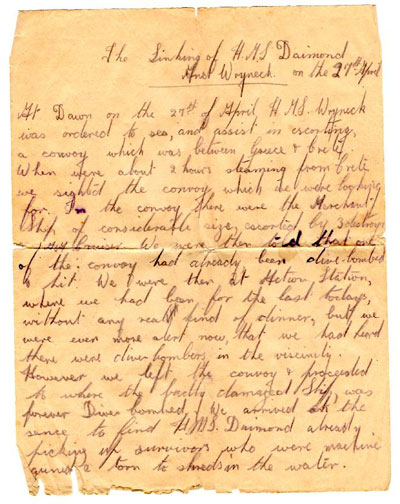
"At dawn on the 27th of April HMS
Wryneck
was ordered to sea, and assist in escorting a convoy which was between
Greece & Crete. When we were about 2 hours steaming from Crete we
sighted the convoy which we were looking for. In the convoy there were
the Merchant ship of considerable size, escorted by 3 destroyers &
HM Cruiser. We were then told that one of the convoy had already been
dive-bombed & hit. We were then at action station, where we had
been for the last to days, without any real kind of dinner, but we were
even more alert now, that we had heard there were dive bombers in the
vicinity. However left the convoy & proceeded to where the badly
damaged Ship, was forever dive bombed. We arrived at the scene to find
H.M.S Diamond already picking up survivors who were machine-gunned
& torn to shreds in the water.
However, we picked up as many as we could, and then a few of them were
already half dead. When we finally satisfied ourselves that there was
nothing more to be done, we made up our minds to return to Crete. That
was about 12.15, so we put ourselves or rather took up our positions.
Diamond then flashed that they were going to torpedo the already badly blazing ship. The
Diamond fired
one only which hit right amid-ships. We saw the vessel give a great
lurch and then begin to sink very quickly. During these operation
Dive-Bombers never came near us. Then when they began to think they
were saved & all was well, out of nowhere came those Junkers 87,
those terrifying dive bombers, with something like vengeance, which
they quickly got. All we knew was when we heard the whining of the
machine & the machine guns & a second later bombs.
I never experienced as much in all the war as I did those next five
minutes. One bomb landed on the forward gun & wiped out nearly
everyone out, then one landed on the after gun but lucky only one was
hurt, the other one or two were near misses, but they did all the
damage. After the Nazis thought they had done a good job which they
nearly had, they never bothered us again, which was to my relief. I
didn’t fancy having a machine gun bullet in me. However the ship now
had a great list to port & was sinking rapidly. My Pal who I owe my
life to found me forward in the (galley flat) and these were the words
he spoke to me quite calmly. They got us, Dolly. Dolly was my nick
name in case you want to know. We went out on the Upper Deck together,
& he said to me, Have you got a life belt,
I said no, I didn’t need one, but he gave me one as he had two and we
did a bit of work together, we untied a Carley Raft & threw it over
the side, however the ship was going about 20 knots & we could not
hold on to it, that we made our objective. We travelled a bit further
on, I should say a few seconds, because all this happened within six
minutes. I look over to have a look at the
Diamond
but it had already gone down. When we finally decided to jump over, me
& my pal, we gripped one oar each, before we went. Believe me they
came in handy. We made to get clear of the oil-fuel which was now
spreading on the water, and then for the rafts which we could not see.
When we had swam a couple of miles together, we noticed that someone
else had got the whaler free so we made for this, eventually I think we
swam about 3 miles before we caught up with the whaler, which we then
noticed had collected two rafts, We got to one of these rafts and
clambered inboard.
The time would then be about 2.15 - 2.30. We kept good hearts and I
joked with a few of my favourite comrades who were in the whaler. I
cannot tell you every little detail, but I’m writing this down to give
an idea what I thought was a terrible ordeal.
It came to dusk & I think we had picked only two more survivors up,
then a rough sea sprang up, as I have already told before we were on a
raft. However it began to get rougher & rougher every minute. The
whaler who was towing us suddenly decided to cut us adrift. We never
thought such a thing could happen among English sailors or more so one
that you share the same ship & eat with. However when we found to
our misfortune that we were actually adrift, we almost gave up. Time
wore on hour after hour went by till we thought that we would never be
picked up when suddenly about half past three in the morning we sighted
a ship but not before they had sighted us, it was a destroyer, one of
those dark grey shapes. We realised but it took quite a bit to do so
that it was making straight toward us, at least that what we thought,
but thank goodness we were wrong. I’ll never forget that night of
terror.
The destroyer finally came along-side us with great skill, and we were
pulled up the side of the ship, our legs were numb & we could
hardly use them, but we were full of smiles. We were treated splendidly
aboard HMS
Griffin which was
the name of the destroyer. I was only interested about getting
something to eat. I didn’t. We got something to drink which did
us the world of good. When we arrived at Crete the same morning I was
relieved & never wanted to go to sea again. But I'll never forget
the splendid behaviour of my ship company."
“It was a scene of total carnage and
devastation. The deck of the ship and the water surrounding was covered
in debris. I managed to find a rope and abseiled down the ship where I
dived into the water. I don’t know if it was bomb shock or just his
sense of humour but in the middle of all this death and destruction a
sailor was clinging to the top of a floating barrel merrily singing
‘roll out the barrel.’ It was quite a surreal moment.”
"I opened my eyes and saw utter
carnage. There were bodies everywhere. I realised I was the only guy in
the mess moving. The ship started to list heavily to one side and
started to sink. I knew I had to get out as quickly as possible.”

 HMS WRYNECK
HMS WRYNECK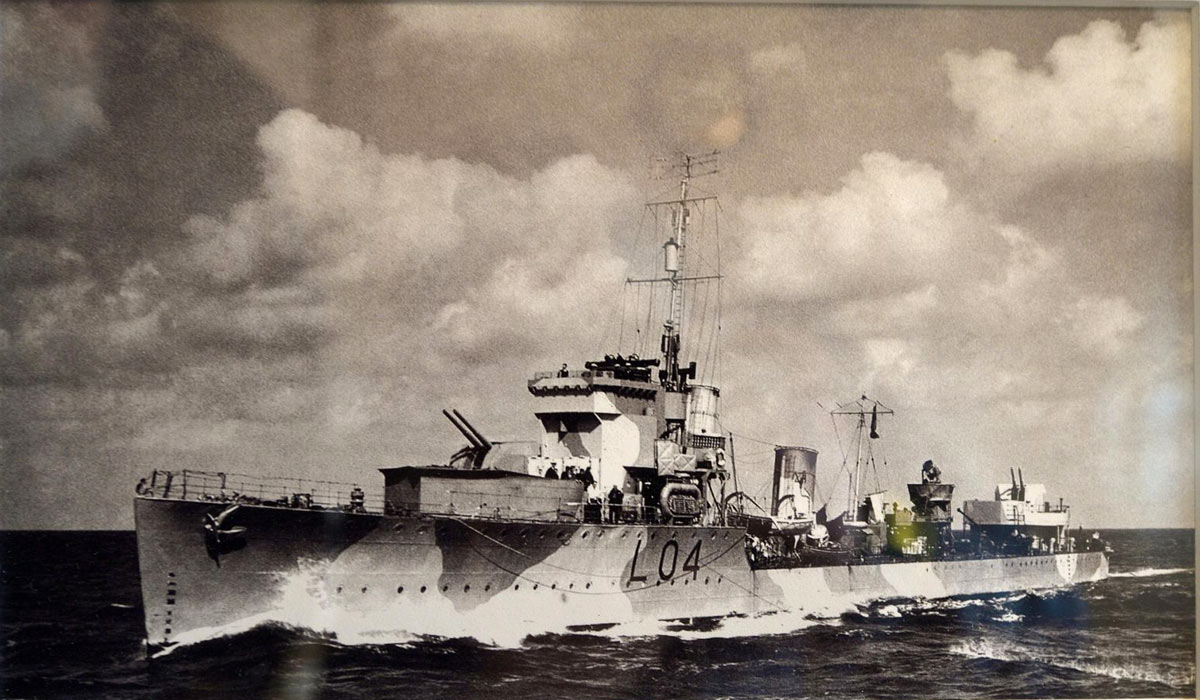
 The
Italian invasion in October 1940, usually known as the Greco-Italian
War, was followed by the German invasion in April 1941. German landings
on the island of Crete (May 1941) came after Allied forces had been
defeated in mainland Greece. The most authorative and detailed account
of the evacuation of the troops from Greece was published in Supplement 38293 to The London Gazette on Tuesday 18 May 1948.
It contains the official accounts of the senior officers responsible
for directing the operation to take allied troops to Greece (Operation Lustre) and Operation Demon to evacuate them after the fall of Greece to German forces, It has been saved as a PDF so that it can
be read online on this website. Although a great tragedy the loss of
HMS Wryneck was only a small part of this operation which successfully evacuated 50,000 troops.
The
Italian invasion in October 1940, usually known as the Greco-Italian
War, was followed by the German invasion in April 1941. German landings
on the island of Crete (May 1941) came after Allied forces had been
defeated in mainland Greece. The most authorative and detailed account
of the evacuation of the troops from Greece was published in Supplement 38293 to The London Gazette on Tuesday 18 May 1948.
It contains the official accounts of the senior officers responsible
for directing the operation to take allied troops to Greece (Operation Lustre) and Operation Demon to evacuate them after the fall of Greece to German forces, It has been saved as a PDF so that it can
be read online on this website. Although a great tragedy the loss of
HMS Wryneck was only a small part of this operation which successfully evacuated 50,000 troops. 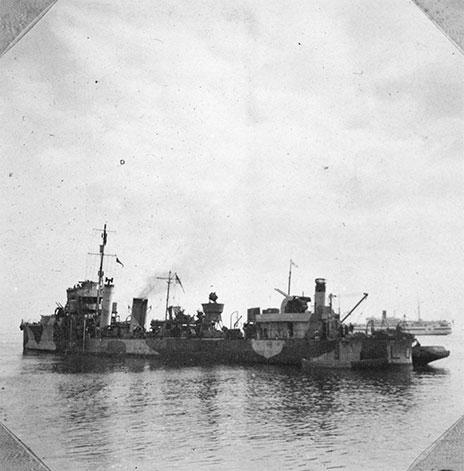
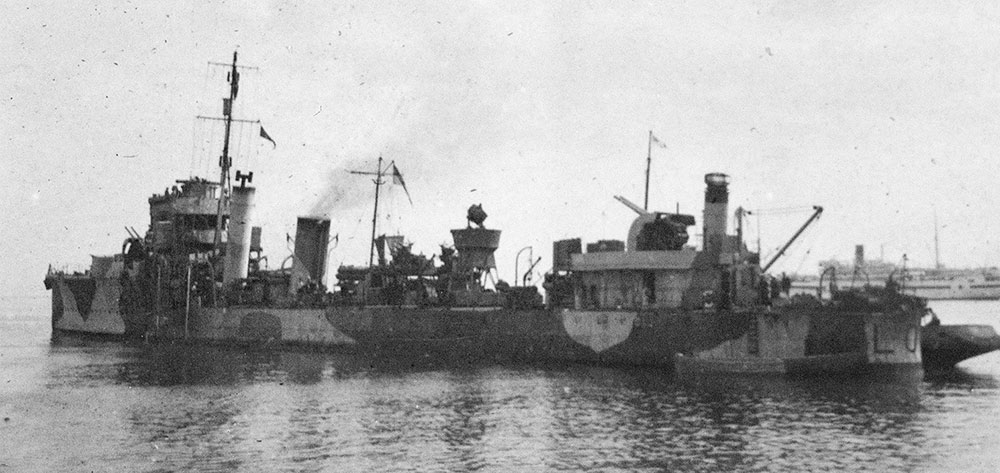
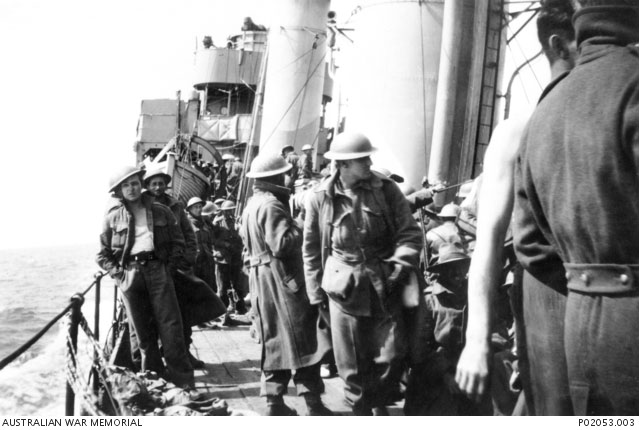
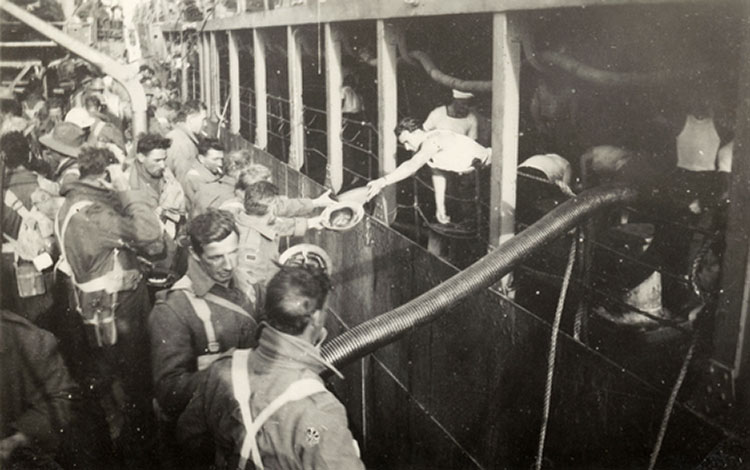


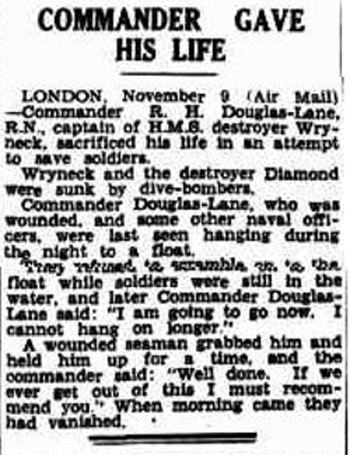
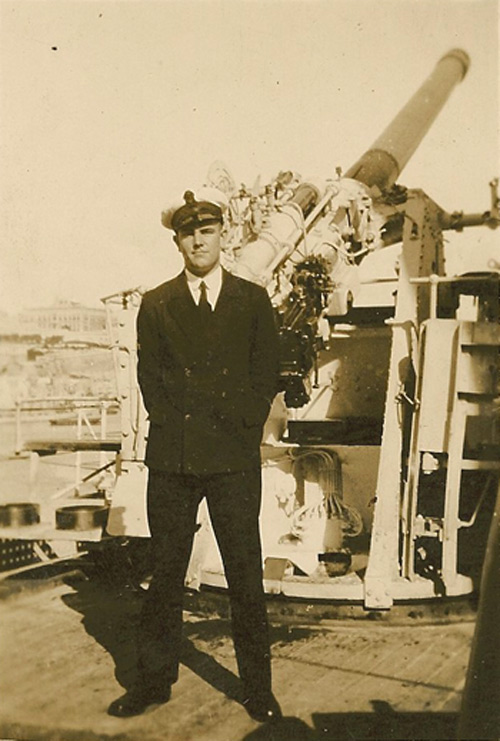
 "At dawn on the 27th of April HMS Wryneck
was ordered to sea, and assist in escorting a convoy which was between
Greece & Crete. When we were about 2 hours steaming from Crete we
sighted the convoy which we were looking for. In the convoy there were
the Merchant ship of considerable size, escorted by 3 destroyers &
HM Cruiser. We were then told that one of the convoy had already been
dive-bombed & hit. We were then at action station, where we had
been for the last to days, without any real kind of dinner, but we were
even more alert now, that we had heard there were dive bombers in the
vicinity. However left the convoy & proceeded to where the badly
damaged Ship, was forever dive bombed. We arrived at the scene to find
H.M.S Diamond already picking up survivors who were machine-gunned
& torn to shreds in the water.
"At dawn on the 27th of April HMS Wryneck
was ordered to sea, and assist in escorting a convoy which was between
Greece & Crete. When we were about 2 hours steaming from Crete we
sighted the convoy which we were looking for. In the convoy there were
the Merchant ship of considerable size, escorted by 3 destroyers &
HM Cruiser. We were then told that one of the convoy had already been
dive-bombed & hit. We were then at action station, where we had
been for the last to days, without any real kind of dinner, but we were
even more alert now, that we had heard there were dive bombers in the
vicinity. However left the convoy & proceeded to where the badly
damaged Ship, was forever dive bombed. We arrived at the scene to find
H.M.S Diamond already picking up survivors who were machine-gunned
& torn to shreds in the water.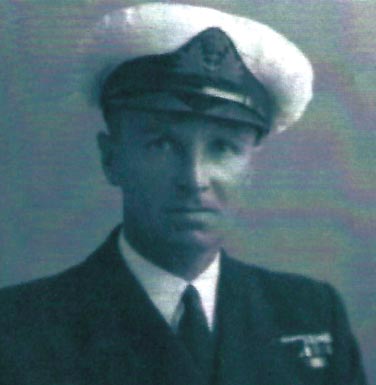
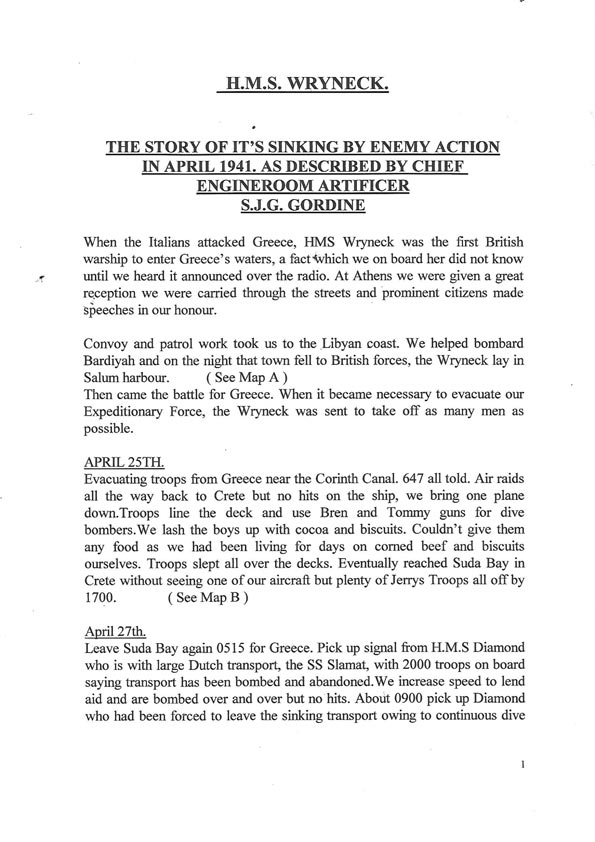
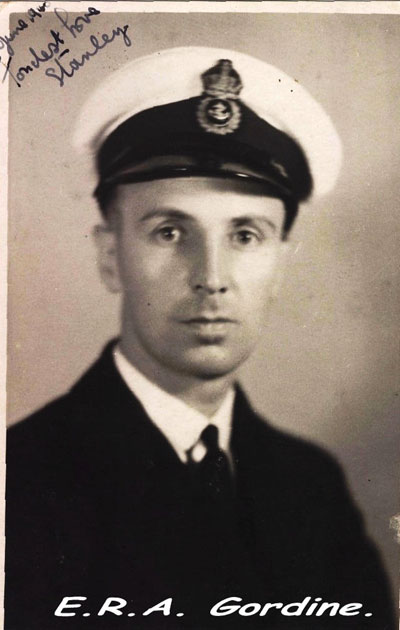
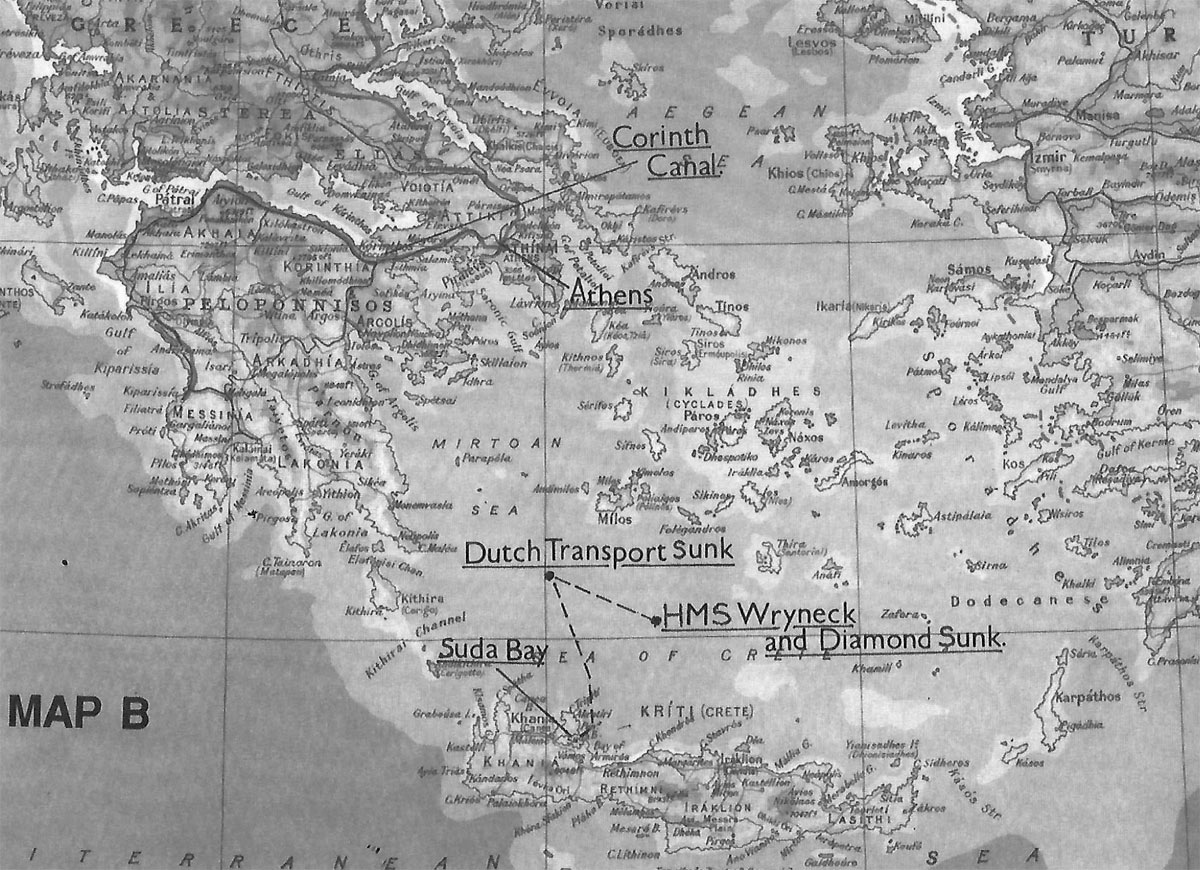
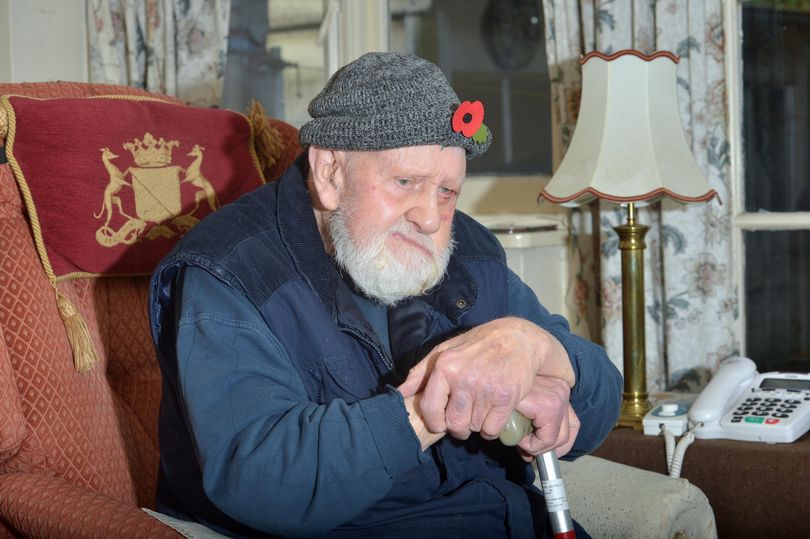
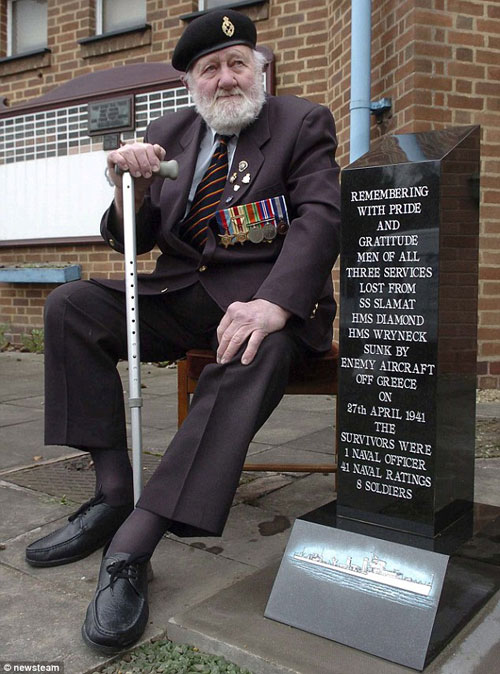 George
Dexter still shakes his head in disbelief when he remembers the day he
survived TWO ship sinkings by the German Luftwaffe. George, who is 96,
is the only known living survivor of the Luftwaffe’s attack on
evacuating Allied ships SS Slamat and HS Diamond,
on April 27 1941, in the Greek Mediterranean during the Second World
War. He was one of just eight soldiers, one naval officer and 41 seamen
to survive the disaster. The other 843 men perished in the attacks.
George
Dexter still shakes his head in disbelief when he remembers the day he
survived TWO ship sinkings by the German Luftwaffe. George, who is 96,
is the only known living survivor of the Luftwaffe’s attack on
evacuating Allied ships SS Slamat and HS Diamond,
on April 27 1941, in the Greek Mediterranean during the Second World
War. He was one of just eight soldiers, one naval officer and 41 seamen
to survive the disaster. The other 843 men perished in the attacks.